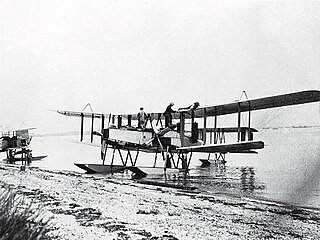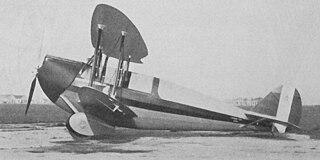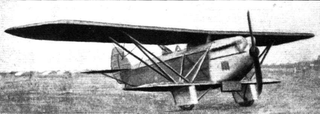Related Research Articles

The Caproni Ca.37 was a ground attack aircraft designed and built in Italy by Caproni around 1916

The Caproni Ca.73 was an Italian airliner produced during the 1920s which went on to serve as a light bomber in the newly independent Regia Aeronautica.

The Caproni Ca.97 was a civil utility aircraft produced in Italy in the late 1920s and early 1930s. As originally designed, it was a high-wing braced trimotor monoplane of conventional configuration with one engine mounted on the nose and the other two carried on strut-mounted nacelles at the fuselage sides. Examples were also produced with only the nose engine or only the two nacelle-mounted engines.

The Caproni Ca.90 was a prototype Italian heavy bomber designed and built by Caproni. When it first flew in 1929 it was the largest land-based aircraft in the world.

The Blackburn G.P seaplane,, was a British twin-engine reconnaissance torpedo floatplane of the First World War, built by the Blackburn Aeroplane and Motor Co Ltd.

The Caproni Ca.125 was a single-engine, tandem two-seat, touring biplane built in Italy in 1933. It could be operated either as a landplane or seaplane.
The Potez 27 was a French reconnaissance biplane first flown in 1924. 175 were operated by the Polish Air Force, most built in Poland by PWS under licence. Others went to Romania, where they were also used as light bombers.

The Descamps 17 A.2 was a two-seat reconnaissance fighter built under a French government programme of 1923. Two versions, with different engines, were tested and six examples were built under licence by Caudron as the Caudron C.17 A.2.

The Caproni Ca.95 was a large, three engine, long range, heavy bomber prototype built in Italy in 1929. It could carry a 1,600 kg (3,500 lb) bomb load and had three defensive gun positions. Only one was built.
The Caproni Ca.61 was an Italian heavy day bomber aircraft of 1922. It was the final development of the Caproni three engine, twin boom biplane types developed during World War I, but it was not put into production.
The Caproni Ca.66 was an Italian night bomber designed to reequip the post-World War I Italian Air Force. Only two examples of the four-engined biplane were built.
The Blériot 117 or B-117 was a large, twin-engined French aircraft from the mid-1920s. Heavily armed with three gun positions, it was designed to defend bomber formations against fighter attack. It did not reach production but was developed into the more successful Blériot 127.

The Caproni Ca.22 was a single-engine monoplane made by the Italian company Aeronautica Caproni in 1913.

The Caproni Ca.11 was a single-engine monoplane designed and built by Caproni in the early 1910s.
The Caproni Ca.72 was an Italian night bomber designed to reequip the post-World War I Italian Air Force.
The Caproni Ca.79 was an Italian light bomber produced in the mid-1920s.
The Caproni Ca.103 was a biplane twin-engine bomber developed by the Italian company Aeronautica Caproni in the late 1920s.
The Caproni Ca.120 was a three-engine monoplane bomber built by Caproni in the 1930s.
The Caproni Ca.127 was a single-engine reconnaissance monoplane built by Caproni in the mid-1930s.

The Caproni Ca.53 was an Italian prototype light bomber built in the last months of World War I.
References
- 1 2 3 Caproni, Gianni (1937). Aeroplani Caproni dal 1908 al 1935 (in Italian). Milan: Edizioni d'arte Emilio Bestetti. pp. 168–174.
- ↑ "Caproni Ca.67". Airwar.ru. Retrieved 2019-02-03.